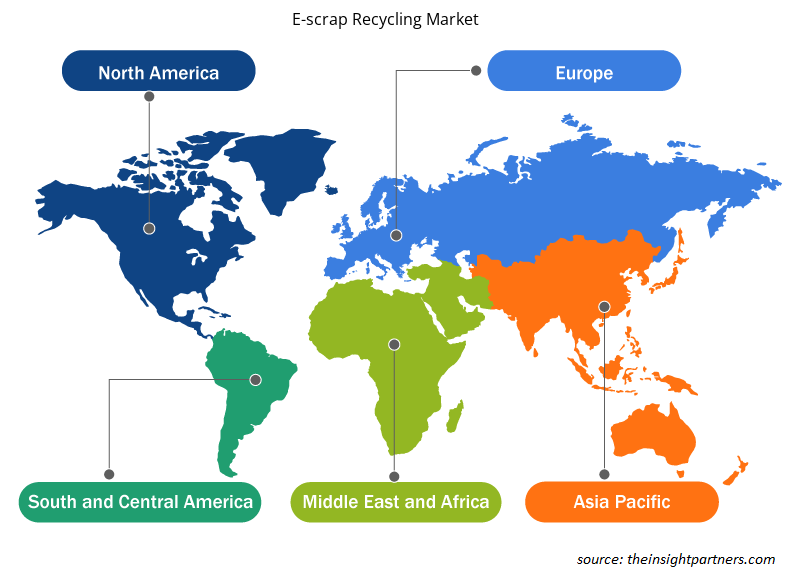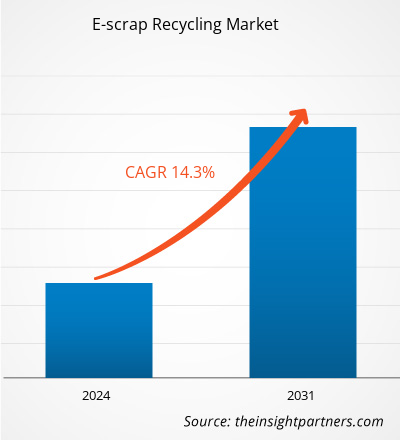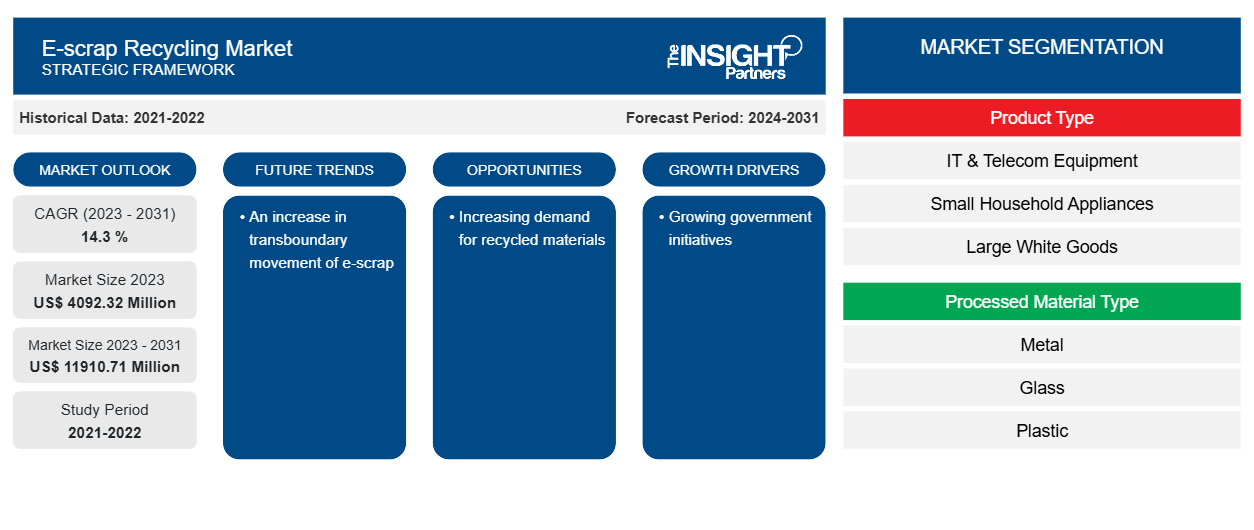Si prevede che la dimensione del mercato del riciclaggio di rottami elettronici raggiungerà 11910,71 milioni di dollari entro il 2031, rispetto ai 4092,32 milioni di dollari del 2023. Si prevede che il mercato registrerà un CAGR del 14,3% nel periodo 2023-2031. È probabile che un aumento del movimento transfrontaliero di rottami elettronici rimanga una tendenza chiave nel mercato.CAGR of 14.3 % during 2023–2031. An increase in transboundary movement of e-scrap is likely to remain a key trend in the market.
Analisi del mercato del riciclaggio dei rottami elettronici
I produttori di elettrodomestici stanno anche offrendo modelli più recenti per attrarre i clienti. Il lancio di nuovi prodotti precede la rottamazione degli elettrodomestici esistenti , il che sta beneficiando gli operatori del mercato del riciclaggio di rottami elettronici. Ciò sta nuovamente trasformando l'industria del riciclaggio di rottami elettronici. Inoltre, poiché i progressi tecnologici stanno avanzando rapidamente in tutto il mondo, i produttori di elettronica di consumo o elettrodomestici con durate di vita limitate. Ciò aiuta i produttori ad aumentare le loro tecnologie nel tempo, con conseguente diminuzione della quantità di depositi di rottami elettronici, che in ultima analisi sta guidando il mercato del riciclaggio di rottami elettronici.
Panoramica del mercato del riciclaggio di rottami elettronici
Il riciclaggio dei rifiuti elettronici è il metodo di estrazione di oggetti di valore dopo aver rimosso i rifiuti elettronici in piccoli pezzi che potrebbero essere riciclati in un nuovo apparecchio elettronico. Il riciclaggio dei rifiuti elettronici ha tutti i tipi di vantaggi, tra cui la protezione dell'ambiente e della salute umana. La maggior parte dei materiali che compongono smartphone e computer derivano da minerali non rinnovabili; il riciclaggio di questi materiali può evitare che la fornitura di beni di consumo che diventano inevitabili nelle vite venga sospesa fino a quando non vengono scoperte delle sostituzioni.
Personalizza questo report in base alle tue esigenze
Riceverai la personalizzazione gratuita di qualsiasi report, comprese parti di questo report, o analisi a livello nazionale, pacchetto dati Excel, oltre a usufruire di grandi offerte e sconti per start-up e università
-
Scopri le principali tendenze di mercato in questo rapporto.Questo campione GRATUITO includerà analisi di dati che spaziano dalle tendenze di mercato alle stime e alle previsioni.
Driver e opportunità del mercato del riciclaggio dei rottami elettronici
Crescenti iniziative governative
I governi di vari paesi stanno prendendo iniziative per il riciclaggio di rottami elettronici. Il governo ha eseguito una serie di misure per formalizzare il settore del riciclaggio di rifiuti elettronici di vari paesi. Le norme di gestione dei rifiuti elettronici prevedono l'autorizzazione obbligatoria delle unità di demolizione e riciclaggio da parte degli enti statali per il controllo dell'inquinamento (SPCB)/comitati per il controllo dell'inquinamento (PCC) coinvolti. Il CPCB ha emanato linee guida per il trattamento dei rifiuti elettronici. Il CPCB e gli SPCB hanno osservato le unità e sono state adottate le misure necessarie per migliorare e modernizzare il settore del riciclaggio con l'aiuto del Ministero dell'elettronica e dell'informatica. Pertanto, le crescenti iniziative governative stanno guidando il mercato del riciclaggio di rottami elettronici.
Crescente domanda di materiali riciclati
I consumatori sono molto soddisfatti dei prodotti realizzati con materiali riciclati che sono anche ecologici alla fine del loro ciclo di vita. In un sondaggio condotto su un'azienda, la grande maggioranza ha ritenuto che i prodotti realizzati con materiali riciclati siano superiori a quelli realizzati con materiali vergini. I consumatori a livello globale sono diventati progressivamente preoccupati per i rifiuti di imballaggio e le perdite nell'ambiente, e i governi hanno iniziato a rispondere al sentimento pubblico con azioni robuste lungo tempistiche accelerate, quindi la domanda di materiali riciclati è in aumento, il che sta creando maggiori opportunità per il mercato.
Analisi della segmentazione del rapporto di mercato sul riciclaggio di rottami elettronici
I segmenti chiave che hanno contribuito alla derivazione dell'analisi di mercato del riciclaggio dei rottami elettronici sono i componenti, il protocollo e l'applicazione.
- In base al tipo di prodotto, il mercato del riciclaggio di rottami elettronici è suddiviso in apparecchiature IT e per telecomunicazioni, piccoli elettrodomestici, grandi elettrodomestici, elettronica di consumo e altri. Il segmento delle apparecchiature IT e per telecomunicazioni ha detenuto una quota di mercato maggiore nel 2023.
- In base al tipo di materiale lavorato, il mercato è segmentato in metallo, vetro, plastica e altri.
Analisi della quota di mercato del riciclaggio di rottami elettronici per area geografica
L'ambito geografico del rapporto sul mercato del riciclaggio dei rottami elettronici è suddiviso principalmente in cinque regioni: Nord America, Asia Pacifico, Europa, Medio Oriente e Africa, Sud e Centro America.
L'APAC domina il mercato del riciclaggio di rottami elettronici. Vari fattori stanno guidando il mercato del riciclaggio di rottami elettronici dell'APAC, come le crescenti iniziative governative, la crescente domanda di materiali riciclati e altro ancora. Pertanto il mercato sta crescendo in modo significativo nella regione.
Approfondimenti regionali sul mercato del riciclaggio dei rottami elettronici
Le tendenze regionali e i fattori che influenzano il mercato del riciclaggio di rottami elettronici durante il periodo di previsione sono stati ampiamente spiegati dagli analisti di Insight Partners. Questa sezione discute anche i segmenti e la geografia del mercato del riciclaggio di rottami elettronici in Nord America, Europa, Asia Pacifico, Medio Oriente e Africa, e Sud e Centro America.

- Ottieni i dati specifici regionali per il mercato del riciclaggio di rottami elettronici
Ambito del rapporto sul mercato del riciclaggio di rottami elettronici
| Attributo del report | Dettagli |
|---|---|
| Dimensioni del mercato nel 2023 | 4092,32 milioni di dollari USA |
| Dimensioni del mercato entro il 2031 | 11910,71 milioni di dollari USA |
| CAGR globale (2023-2031) | 14,3% |
| Dati storici | 2021-2022 |
| Periodo di previsione | 2024-2031 |
| Segmenti coperti |
Per tipo di prodotto
|
| Regioni e Paesi coperti |
America del Nord
|
| Leader di mercato e profili aziendali chiave |
|
Densità degli attori del mercato: comprendere il suo impatto sulle dinamiche aziendali
Il mercato del riciclaggio di rottami elettronici sta crescendo rapidamente, spinto dalla crescente domanda degli utenti finali dovuta a fattori quali l'evoluzione delle preferenze dei consumatori, i progressi tecnologici e una maggiore consapevolezza dei vantaggi del prodotto. Con l'aumento della domanda, le aziende stanno ampliando le loro offerte, innovando per soddisfare le esigenze dei consumatori e capitalizzando sulle tendenze emergenti, il che alimenta ulteriormente la crescita del mercato.
La densità degli operatori di mercato si riferisce alla distribuzione di aziende o società che operano in un particolare mercato o settore. Indica quanti concorrenti (operatori di mercato) sono presenti in un dato spazio di mercato in relazione alle sue dimensioni o al valore di mercato totale.
Le principali aziende che operano nel mercato del riciclaggio dei rottami elettronici sono:
- Società a responsabilità limitata DOWA HOLDINGS CO.
- Ecoreco srl
- Riciclatori elettronici internazionali Inc.
- Società a responsabilità limitata
- Società per l'estrazione mineraria e i metalli della JX Nippon
- Gestione dei metalli Sims Ltd
Disclaimer : le aziende elencate sopra non sono classificate secondo un ordine particolare.

- Ottieni una panoramica dei principali attori del mercato del riciclaggio di rottami elettronici
Notizie e sviluppi recenti sul mercato del riciclaggio di rottami elettronici
Il mercato del riciclaggio di rottami elettronici viene valutato raccogliendo dati qualitativi e quantitativi post-ricerca primaria e secondaria, che includono importanti pubblicazioni aziendali, dati di associazioni e database. Di seguito sono elencati alcuni degli sviluppi nel mercato del riciclaggio di rottami elettronici:
- Il governo presto creerà una piattaforma online per facilitare il commercio di certificati di responsabilità estesa del produttore (EPR). Questa mossa aiuterà il paese ad affrontare la crescente minaccia dei rifiuti elettronici, come cellulari e laptop fuori uso. (Fonte: Extended Producer Responsibility (EPR), comunicato stampa, marzo 2024.)
- Questa settimana i principali produttori di elettronica si sono uniti alla Consumer Technology Association per formare la Consumer Technology Circularity Initiative, che mira a potenziare l'elaborazione dei rottami elettronici, migliorare la riparazione e il riutilizzo e incorporare più contenuti riciclati nei prodotti. (Fonte: Consumer Technology Association, comunicato stampa, gennaio 2024)
Copertura e risultati del rapporto sul mercato del riciclaggio di rottami elettronici
Il rapporto “Dimensioni e previsioni del mercato del riciclaggio di rottami elettronici (2021-2031)” fornisce un’analisi dettagliata del mercato che copre le seguenti aree:
- Dimensioni e previsioni del mercato del riciclaggio dei rottami elettronici a livello globale, regionale e nazionale per tutti i principali segmenti di mercato coperti dall'ambito
- Tendenze del mercato del riciclaggio dei rottami elettronici e dinamiche di mercato come fattori trainanti, limitazioni e opportunità chiave
- Analisi dettagliata delle cinque forze PEST/Porter e SWOT
- Analisi del mercato del riciclaggio dei rottami elettronici che copre le principali tendenze del mercato, il quadro globale e regionale, i principali attori, le normative e i recenti sviluppi del mercato
- Analisi del panorama industriale e della concorrenza che copre la concentrazione del mercato, l'analisi della mappa termica, i principali attori e gli sviluppi recenti nel mercato del riciclaggio dei rottami elettronici
- Profili aziendali dettagliati
- Analisi storica (2 anni), anno base, previsione (7 anni) con CAGR
- Analisi PEST e SWOT
- Valore/volume delle dimensioni del mercato - Globale, Regionale, Nazionale
- Industria e panorama competitivo
- Set di dati Excel
Report recenti
Testimonianze
Motivo dell'acquisto
- Processo decisionale informato
- Comprensione delle dinamiche di mercato
- Analisi competitiva
- Analisi dei clienti
- Previsioni di mercato
- Mitigazione del rischio
- Pianificazione strategica
- Giustificazione degli investimenti
- Identificazione dei mercati emergenti
- Miglioramento delle strategie di marketing
- Aumento dell'efficienza operativa
- Allineamento alle tendenze normative























 Ottieni un campione gratuito per - Mercato del riciclaggio dei rottami elettronici
Ottieni un campione gratuito per - Mercato del riciclaggio dei rottami elettronici